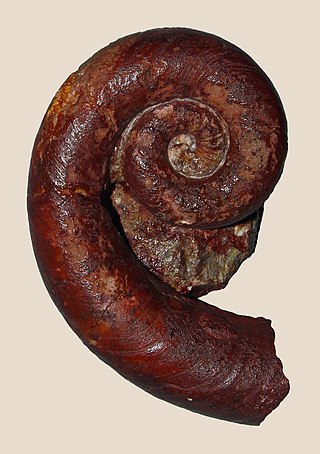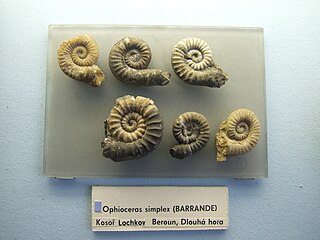
Trocholites is a tarphycerid genus in the family Trocholitidae from the Middle and Late Ordovician with a gradually expanding, weakly ribbed shell; whorls in contact, dorsum slightly impressed; cross section depressed, venter and sides rounded; siphuncle close to but not at the dorsal margin.

Discoceras is an extinct marine cephalopod mollusk, a member of the Trocholitidae in the Tarphycerida. It is distinct from Discosorus, It is characterized by closely coiled, gradually expanding shells with a subquadrate cross section, that may be ribbed or smooth. The sides are broadly rounded; the venter is wide and slightly rounded. The maximum width is slightly dorsal of the middle. The dorsum has a slight to moderate impression. The siphuncle starts off central for the first half whorl then becomes marginodorsal in the succeeding two whorls, then subdorsal at maturity. As with Trocholites, the dorsal siphuncle in Discoceras probably indicates an orientation during life that places the back of the living chamber high in the shell.

The Tarphycerida were the first of the coiled cephalopods, found in marine sediments from the Lower Ordovician to the Middle Devonian. Some, such as Aphetoceras and Estonioceras, are loosely coiled and gyroconic; others, such as Campbelloceras, Tarphyceras, and Trocholites, are tightly coiled, but evolute with all whorls showing. The body chamber of tarphycerids is typically long and tubular, as much as half the length of the containing whorl in most, greater than in the Silurian Ophidioceratidae. The Tarphycerida evolved from the elongated, compressed, exogastric Bassleroceratidae, probably Bassleroceras, around the end of the Gasconadian through forms like Aphetoceras. Close coiling developed rather quickly, and both gyroconic and evolute forms are found in the early middle Canadian.
Tarphyceras is a genus of tarphyceratid with whorls rounded in cross section, having a deeply impressed dorsum and a ventral to subcentral siphuncle, known from the Lower Ord of North America. It differs from Campbelloceras in that Campbelloceras is only slightly impressed, from Centrotarphyceras in that Centrotarphyceras is subquadrate and has a central siphuncle, and from Trocholites in that although Trocholites is subcircular in cross section, the siphuncle is subdorsal.
Campbelloceras is a tarphyceratid nautiloid known from the Lower Ordovician, Upper Canadian Epoch of North America, where it is widespread. Campbelloceras was named by Ulrich and Foerste in 1936.
Litoceras is a trocholitid (Tarphycerida) genus that has been found in the Lower and Middle Ordovician of Newfoundland. Whorls in Litoceras have a broadly rounded cross section with its width greater than its height. Litoceras somewhat resembles the tarphyceratid Pionoceras from the same time, except for the siphuncle being dorsal and in the center.
Curtoceras is a genus in the tarphycerid family Trocholitidae found widespread in the late Early and Middle Ordovician of North America and northern Europe. Curtoceras has a shell that is gradually expanded, with half the fully mature body chamber divergent from the preceding volution. Whorl sections are near equidimentional with the inner margin (dosum) moderately impressed. The surface may be smooth or weakly ribbed. The siphuncle is ventral in the initial chamber and becomes dorsal after one volution. With the exception of the dorsal siphuncle, Curtoceras is somewhat similar to the tarphyceratid Campbelloceras

The Trocholitidae are Tarphycerida with whorls in close contact as with the Tarphyceratidae, but in which the siphuncle, similar in structure, becomes dorsal. The Trocholitidae are derived from the Tarphyceratidae, perhaps from different tarphyceratids.
Basslerocerida is an order of nautiloid cephalopods from the Ordovician comprising exogastric longiconic cyrtocones, that is no longer in common use.

The Trigonoceratoidea are a superfamily within the Nautilida that ranged from the Devonian to the Triassic, thought to have contained the source for the Nautilaceae in which Nautilus is found.
The Bassleroceratidae is a family of gradually expanding, smooth ellesmerocerids with a slight to moderate exogastric curvature, subcircular to strongly compressed cross section, and ventral orthochaonitc siphuncle. The ventral side is typically more sharply rounded than the dorsal side and septa are close spaced. Connecting rings are thick and slightly expanded into the siphuncle, making the segments slightly concave; characteristic of the Ellesmerocerida.
Syringonautilidae is a family of Nautiloidea from the middle to late Triassic. Syringonautilidae comprise the last of the Trigonoceratoidea and are the source for the Nautilaceae which continued the Nautiloidea through the Mesozoic and into the Cenozoic right down to the recent. Syringonautilidae is a strictly Triassic family, derived early in the Triassic from the Grypoceratidae.
The Centroceratidae is the ancestral family of the Trigonoceratoidea and of the equivalent Centroceratina; extinct shelled cephalopods belonging to the order Nautilida
Bassleroceras is an elongate upwardly curved, exogastric, genus with the venter on the under side more sharply rounded than the dorsum on the upper. The siphuncle is ventral, composed of thick-walled tubular segments in which connection rings thicken in towardly as in both the Ellesmerocerida and primitive Tarphycerida.

The Estonioceratidae are a family of loosely coiled tarphycerids in which the inner side of the whorls, which forms the dorsum, is rounded or flat with no impression, and in which the siphuncle, composed of thick tubular segments, is located ventrally. The Estonioceratidae seem to form a link between the ancestral Bassleroceratidae and the more tightly coiled Tarphyceratidae.
Enoploceras is a Tainoceratid genus, a nautiloid cephalopod in the order Nautilida, known from Triassic sediments in Europe, India, Timor, and the state of Idaho.

Ophioceras is a genus of closely coiled tarphycerid nautiloid cephalopods, the sole representatives of the family Ophidioceratidae, characterized by an evolute shell with narrow, subrounded, annulated whorls and a subcentral siphuncle composed of thin connecting rings that show no evidence of layering. The mature body chamber is strongly divergent and is the longest proportionally of any tarphycerid. The aperture has a deep hyponomic sinus and ocular sinuses, and so resembles some lituitids.
Plectoceras is a genus of nautiloids included in the tarphycerid suborder Barrandeocerina that lived during the Middle and Late Ordovician. It has been found widespread in the Middle and Upper Ordovician of North America.

Alaskoceras is a genus of lower Ordovician coiled nautiloid cephalopods; the shell moderately expanded, ribbed, with a divergent living chamber; whorl section more broadly rounded ventrally than dorsally; siphuncle marginal at maturity, septal necks short, almost achoanitic; connecting rings thick, layered.

Domatoceras is a nautiloid genus and member of the Grypoceratidae from the Pennsylvanian and Permian with a wide spread distribution.







